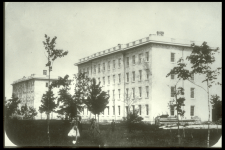South College

- Begun in 1848, completed in 1849
- Nearly identical to Mason Hall, from which it was separated by a space of 150 feet
- Estimated cost: $13,000.00
- A July, 1848, motion by a Regents' committee to name the building Pitcher Hall after Dr. Zina Pitcher--a founder of the University's Medical School and member of the first Board of Regents--was tabled and never taken up again
[View more images of South Hall]
In January, 1847, the Regents considered a proposal to construct a second academic building for the University. This proposal was motivated by the need for additional dormitory space for students as well as by the need for chemical and medical laboratory facilities. The new building was intended to be similar in dimension and appearance to Mason Hall and was separated from it by a gap of 150 feet.
Construction commenced in 1848 and was completed in 1849. In July, 1848, the regents considered, but tabled, a proposal to name the new building Pitcher Hall in honor of Dr. Zina Pitcher, a founder of the Medical School and one of the members of the first Board of Regents. The new building became known as South College, a name which it retained until it was incorporated into University Hall in 1871 as the south wing.
The new structure was put to varying uses, but was essential in relieving the overcrowding in Mason Hall. The University's Chemical Laboratory, set up in Mason Hall in 1844, was moved to the new building upon its completion.
In 1853, the University's first professorship in engineering was established. Much of the non-laboratory instruction in this subject was conducted in South College until 1890. At that time the southeastern Professor's House (where the Clements Library now stands) was renovated and enlarged to serve as the home for the Engineering College. From that time on, the chief use for South College (by then the south wing of University Hall) was as classrooms for the natural sciences. The University Treasurer's offices occupied the ground floor of the building.
A fire broke out on May 28, 1913, in the Botanical Laboratory at the southern end of the top floor, resulting in an estimated $47,000.00 worth of damage, including the collapse of a portion of the roof. Full restoration of South College was promptly voted by the Regents. South College continued to provide classroom space for the University, but was plagued by continuing deterioration. In 1950, after a fire destroyed Haven Hall, the entire University Hall complex was removed to make room for the expansion of Angell Hall.
Sources: The University of Michigan: An Encyclopedic Survey; Walter A. Donnelly, Wilfred B. Shaw, and Ruth W. Gjelsness, editors; Ann Arbor : University of Michigan Press, 1958